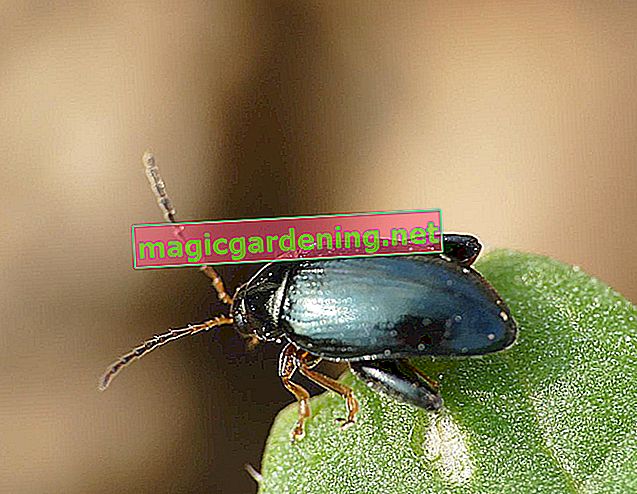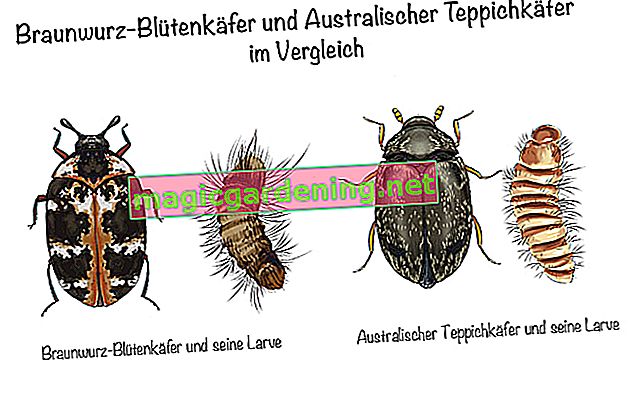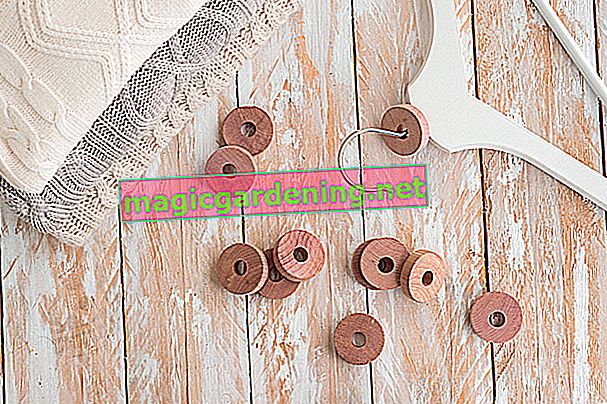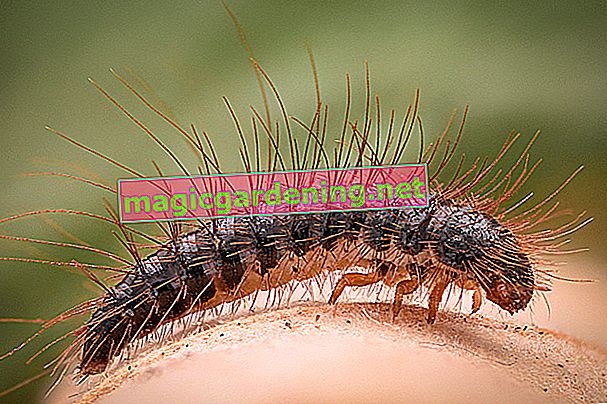
the essentials in brief
- Larvae are clearly recognizable by their long bristle hair. The Australian carpet beetle has a long bristle tail, while the figwort flower beetle has two hair tails. Adult beetles are easier to spot.
- Shaved textiles and carpets as well as peeling residues indicate an infestation. How much the pest has spread can be estimated from the number and condition of beetles and larvae.
- In order to get rid of larvae in the bed and wardrobe, cleaning actions are necessary. In addition to thermal treatments, natural products help.
- Even if the larvae pose a health risk, a positive infestation determination should not degenerate into panic.
How do I recognize the larva of the carpet beetle?

There are two types known as carpet beetles. The figwort flower beetle flies in Europe between May and July. As a pest and culture follower, like the Australian carpet beetle, it can be observed in apartments and houses all year round. The larvae of carpet beetles have an elongated body that is provided with bristly tufts of hair. The untrained eye cannot identify the species on the basis of the larvae. A microscope is required to identify species-specific antennae shapes.
also read
- Recognize and eliminate carpet beetles and larvae
- June beetle - detect, prevent and fight
- Lilies - identify and control pests
This is what carpet beetle larvae look like:
- become up to six millimeters long
- have thick hair and additional defensive hair
- brownish in color with ringed body segments
- Arrow hair at the end of the abdomen
background
Arrow hair for species identification
These special hairs are used to ward off enemies. In the figwort flower beetle, they lie in two tufts on the abdomen. If the larva is in danger, it spreads the tufts of hair and the defensive hair can easily break off. On closer inspection, the larva of the figwort flower beetle differs from that of the Australian carpet beetle. Its larva has long arrow hairs that protrude beyond the end of the abdomen and form a tail. Pictures should be used to better identify carpet beetle larvae.
Differentiation of the species
Both species, which belong to different genera, feed on substances containing keratin and chitin. The club-like antennae are typical of adult beetles. In contrast to the larvae, they are easy to identify. While the Australian carpet beetle has an oval body shape, the figwort flower beetle appears in a spherical shape. Its scales wear off over the course of life, so the color can vary.
| Figwort flower beetle | Australian carpet beetle | |
|---|---|---|
| genus | Anthrenus | Anthrenocerus |
| size | up to 4.5 millimeters | up to 3.5 millimeters |
| body paint | black | red-brown to black |
| Wing coverts | colorful scales | narrow light zigzag bands |
What helps with an infestation by carpet beetle larvae?
Carpet beetles are difficult to control because their larvae are light-shy and live in secret. To bring the pest infestation under control, the right measures, thorough hygiene and patience are important. One trap is not enough to combat it. They only attract male beetles that may have already reproduced.
YoutubeRecognize an infestation
Carpet beetles are storage, hygiene and textile pests. When they have spread in the closet, their larvae leave irregular feeding tracks in the clothing. These resemble the feeding marks of clothes moths, but can be traced back to the causer due to the lack of webs.
- Furs and pelts look like they have been shaved off
- Hair is eaten off at the base of the skin and falls out in clumps
- Similar damage to short-haired and long-haired carpets
- Fecal pellets and moults
Infestation Assessment
You can use the following table to estimate the severity of the infestation. Please note that the information is intended to provide an initial orientation and does not provide a reliable result for the extent of the infestation. Pheromone traps, which are equipped with adhesive strips and attractants, provide another way of estimating.
| possible location | possible intensity of infestation | Possible Cause | first measures | |
|---|---|---|---|---|
| a dead beetle | kitchen | low | stray insect that has not found optimal living conditions | Clear out the cabinet and thoroughly vacuum out cracks |
| many dead bugs | well-locked closets | medium | Larvae successfully developed, but beetles could not find a way out | Thoroughly clean, search for possible hiding places and observe the infestation |
| numerous live beetles | Windowsill | high | successful larval development with increased risk of re-reproduction | Search pantries and wardrobes for further information |
| few brown, immobile larvae | Wardrobe or pantry | low to medium | suboptimal living conditions so that larvae could not pupate | Clear out the cabinet and thoroughly vacuum out cracks |
| white shell | between textiles and carpet fibers | medium to high | optimal food and temperature conditions | Check food and clothing for signs of eating |
Getting rid of larvae in the closet

Shake out the fabrics and wash clothes at at least 60 degrees. Alternatively, you can wrap the pieces in a plastic bag and put it in the freezer for at least two weeks. At extremely high or low temperatures, larvae and eggs die, with the heat treatment showing results within a few hours. To prevent the beetles from laying eggs again in the closet, you should lay out a piece of cedar wood.
Tips
Roughen the surface of the cedar wood piece with some sandpaper so that the essential oils flow off. You can repeat this regularly.
Eliminate larvae in bed
If possible, move the mattress outside so that it can air out and dry off. As a result, the living conditions for carpet beetle larvae worsen and you can thoroughly knock out the surface. If the cover is removable, you should wash it at at least 60 degrees. Otherwise, vacuum the material thoroughly with an upholstery nozzle.
A find of carpet beetle larvae should not degenerate into panic. It is better to have a well thought-out approach to combat.
Also clean the bed box with lukewarm water and a few drops of tea tree oil. Vacuum all niches and crevices in the area. Lavender bags have a deterrent effect and protect against the re-spread of the bugs in the bedroom.
Capture hidden larvae
Vacuum gaps with a narrow upholstery nozzle. If possible, remove baseboards and move upholstered furniture and cabinets to capture any eggs, larvae, and molting debris. Since the light-shy larvae retreat deep into crevices or in soft wood to pupate there, additional means should be used:
- Mineral powder : apply diatomaceous earth, silicate powder, kieselguhr
- Essential oils : spray aqueous neem oil solution
- Insecticides : Spray PBO-free agents with pyrethrum into the cracks
How should I deal with a carpet beetle infestation?
Finding larvae under the bed, in the closet or on the cupboard shelves is not a nice experience. Many people experience disgust and panic easily. After making a discovery like this, stay calm. It is important that you identify a possible infestation and, if the result is positive, act with patience.
Method:
- Find the center by searching for nearby niches
- Check stored clothing, storage cupboards and upholstered furniture
- Dispose of contaminated food immediately
- Shake infected textiles in the open air and treat them thermally
- Empty the cupboards and vacuum them thoroughly
The danger of carpet beetle larvae

Larvae have arrow hairs that are used to ward off predators. They are also dangerous for humans because they cause allergic reactions in the airways when inhaled or wheals and redness when they come into contact with the skin. Such symptoms are reminiscent of bites, but the larvae have too weak mouthparts to damage human skin.
Tips
If you discover a larva, you should suck it away immediately. Apparently lifeless specimens often play dead when touched.
frequently asked Questions
How can I protect myself from carpet beetle infestation?
Carpet beetles often find their way into the apartment from outside. To prevent this, you should provide windows and doors with fly screens. Before storing winter clothing for a long period of time, we recommend cleaning the textiles. Sweat and flakes of skin magically attract larvae. If you are one of the pet owners, clean the sleeping and feeding areas regularly so that no food remains or hair and feathers are left behind.
Do larvae spread all over the house?
In principle, it is possible for nested carpet beetles to spread in different rooms. However, this only occurs if you do nothing to prevent the pest from spreading. You can often find the larvae in bed boxes, wardrobes or in the pantry. The damage is usually concentrated in one place if the feeding conditions are optimal here.
How do carpet beetles reproduce?
The figwort flower beetle flies between May and June to look for a partner. After successful mating, females look for a protected hiding place to lay their eggs. They lay their eggs in a suitable food substrate and often get lost in apartments through open windows and doors. Here they look for materials of animal origin such as wool textiles, furs or carpets made of natural fibers without a system. The first larvae hatch after 15 days and molt up to twelve times before pupating. In the coming spring the beetles hatch and fly out again.
Are there similar types?
The carpet beetle (Anthrenus scrophulariae) belongs to the family of bacon beetles, which is represented with 144 species in Europe. Many relatives are material and hygiene pests. Cabinet beetles and woolly flower beetles from the same genus cause problems. Both are also known as museum beetles because they destroy zoological collections. The Australian carpet beetle, which belongs to the genus Anthrenocerus, shows a similar way of life. Fur beetles come from the genus Attagenus, while the Berlin beetle belongs to the Trogoderma species.








